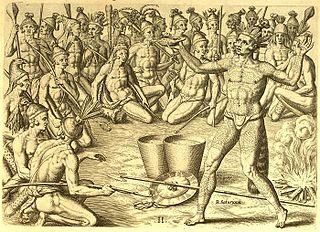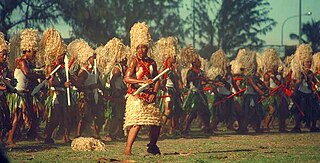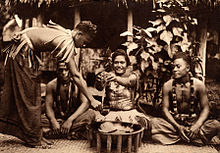
Kava or kava kava is a crop of the Pacific Islands. The name kava is from Tongan and Marquesan, meaning 'bitter'; other names for kava include ʻawa (Hawaiʻi), ʻava (Samoa), yaqona or yagona (Fiji), sakau (Pohnpei), seka (Kosrae), and malok or malogu. Kava is consumed for its sedating effects throughout the Pacific Ocean cultures of Polynesia, including Hawaii and Vanuatu, Melanesia, some parts of Micronesia, such as Pohnpei and Kosrae, and the Philippines.

Turkish coffee is a style of coffee prepared in a cezve using very finely ground coffee beans without filtering.
The traditional culture of Samoa is a communal way of life based on Fa'a Samoa, the unique socio-political culture. In Samoan culture, most activities are done together. The traditional living quarters, or fale (houses), contain no walls and up to 20 people may sleep on the ground in the same fale. During the day, the fale is used for chatting and relaxing. One's family is viewed as an integral part of a person's life. The aiga or extended family lives and works together. Elders in the family are greatly respected and hold the highest status, and this may be seen at a traditional Sunday umu.

Samoans or Samoan people are the indigenous Polynesian people of the Samoan Islands, an archipelago in Polynesia, who speak the Samoan language. The group's home islands are politically and geographically divided between the Independent State of Samoa and American Samoa, an unincorporated territory of the United States of America. Though divided by national border, the culture and language are the same.
Kava cultures are the religious and cultural traditions of western Oceania which consume kava. There are similarities in the use of kava between the different cultures and islands, but each one also has its own traditions.

Black drink is a name for several kinds of ritual beverages brewed by Native Americans in the Southeastern United States. Traditional ceremonial people of the Yuchi, Caddo, Chickasaw, Cherokee, Choctaw, Muscogee and some other Indigenous peoples of the Southeastern Woodlands used the black drink in purification ceremonies. It was occasionally known as white drink because of the association of the color white with peace leaders in some Native cultures in the Southeast.

The Tongan archipelago has been inhabited for perhaps 3,000 years, since settlement in late Lapita times. The culture of its inhabitants has surely changed greatly over this long time period. Before the arrival of European explorers in the late 17th and early 18th centuries, the Tongans were in frequent contact with their nearest Oceanic neighbors, Fiji and Samoa. In the 19th century, with the arrival of Western traders and missionaries, Tongan culture changed dramatically. Some old beliefs and habits were thrown away and others adopted. Some accommodations made in the 19th century and early 20th century are now being challenged by changing Western civilization. Hence Tongan culture is far from a unified or monolithic affair, and Tongans themselves may differ strongly as to what it is "Tongan" to do, or not do. Contemporary Tongans often have strong ties to overseas lands. They may have been migrant workers in New Zealand, or have lived and traveled in New Zealand, Australia, or the United States. Many Tongans now live overseas, in a Tongan diaspora, and send home remittances to family members who prefer to remain in Tonga. Tongans themselves often have to operate in two different contexts, which they often call anga fakatonga, the traditional Tongan way, and anga fakapālangi, the Western way. A culturally adept Tongan learns both sets of rules and when to switch between them.
The culture of Fiji is a tapestry of native Fijian, Indian, European, Chinese, and other nationalities. Culture polity traditions, language, food costume, belief system, architecture, arts, craft, music, dance, and sports will be discussed in this article to give you an indication of Fiji's indigenous community but also the various communities which make up Fiji as a modern culture and living. The indigenous culture is an active and living part of everyday life for the majority of the population.
Bulou is a title used by Fijian women of chiefly rank, in the Provinces of Nadroga-Navosa and Kadavu, and parts of Serua Province, in Fiji.

A nakamal is a traditional meeting place in Vanuatu. It is used for gatherings, ceremonies and the drinking of kava.
Sāngone, was the name of a turtle from divine origin and featuring in Tongan myths about the Tuʻi Tonga king named Tuʻitātui in the beginning of the 12th century AD. Part of the history features prominently in a famous lakalaka written by queen Sālote somewhere around 1940, when the shell, claimed to be the original one from Sāngone herself, was transferred to the Tupou College museum.
Sau Mai Kedekede now more commonly referred to as Sau ni Vanua ko Lau is one of the preeminent titles held by the Paramount Chief of the Lau Islands in Fiji.
Fijian tradition and ceremony is a living way of life that has evolved as the Fijian nation has modernised over time, with various external influences from Pacific neighbours, and the European and Asian society. This general overview of various aspects of Fijian tradition, social structure and ceremony, much of it from the Bauan Fijian tradition although there are variations from province to province, uses "Fijian" to mean indigenous Fijians or I Taukei rather than all citizens of Fiji, and the Fijian terms are most often of the Bauan dialect. Many social intricacies depend on one's inherited social position and the occasion one is confronted with: each will have a particular social etiquette.

Dance in Burma can be divided into dramatic, folk and village, and nat dances, each having distinct characteristics. Although Burmese dance resemble the traditional dancing style of its neighbors, in particular [Dance in Cambodia ], it retains unique qualities that distinguish it from other regional styles, including angular, fast-paced and energetic movements and emphasis on pose, not movement.

Fijian cuisine has long consisted of primarily foraged and farm-grown food. Although rice, wheat, and tea all became staples during Fiji's colonial era, native Fijians still eat primarily tubers and coconuts. The cuisine of Fiji is known for its seafood and various green vegetables, including ''ota'', a young forest fern, and ''bele'', a plant that resembles spinach.

The ʻava ceremony is one of the most important customs of the Samoa Islands. It is a solemn ritual in which a ceremonial beverage is shared to mark important occasions in Samoan society. The Samoan word ʻava is a cognate of the Polynesian word kava associated with the kava cultures in Oceania. Both terms are understood in Samoa.

Coronations in Oceania are, or were, held in the following countries:
Tongan kava ceremonies play an integral part of Tongan society and governance. Ranging from informal “faikava” or kava “parties” to the highly stratified, ancient, and ritualized Taumafa Kava, or Royal Kava Ceremony, Tongan kava ceremonies continue to permeate Tongan society both in Tonga and diaspora, strengthening cultural values and principles, while solidifying traditional ideals of duty and reciprocity, reaffirming societal structures, and entrenching the practice of pukepuke fonua, or tightly holding on to the land, a Tongan cultural ideal to maintain, preserve, and live traditional Tongan culture.

The kātoaga is a customary festival in Wallis and Futuna, a French overseas collectivity in Oceania with a Polynesian culture. During this ceremony, goods are exchanged, such as pigs, baskets of vegetables, banigs, tapa or envelopes filled with banknotes. It takes place on the occasion of religious festivals, political events or private events. Of ancient origin and present in many Polynesian societies, the katoaga obeys a strict ritual and protocol that has changed little since the Christianization of Wallis and Futuna in the 19th century. It begins with a Catholic mass, is followed by a meal, a kava ceremony and dances performed by the villagers, before the food brought by the inhabitants is redistributed to the dignitaries and the population, each gift being allocated according to the rank of the person for whom it is intended. Speeches, poems and stories from the oral tradition are recited by the participating dignitaries. These major customary celebrations mobilize several villages or districts, and require several weeks or even months of preparation.













